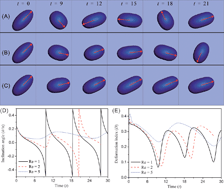Inertia-dependent dynamics of three-dimensional vesicles and red blood cells in shear flow†
Abstract
A three-dimensional (3D) simulation study of the effect of inertia on the dynamics of vesicles and red blood cells (RBCs) has not been reported. Here, we developed a 3D model based on the front tracking method to investigate how inertia affects the dynamics of spherical/non-spherical vesicles and biconcave-shaped RBCs with the Reynolds number ranging from 0.1 to 10. The results showed that inertia induced non-spherical vesicles transitioned from tumbling to swinging, which was not observed in previous 2D models. The critical viscosity ratio of inner/outer fluids for the tumbling–swinging transition remarkably increased with an increasing Reynolds number. The deformation of vesicles was greatly enhanced by inertia, and the frequency of tumbling and tank-treading was significantly decreased by inertia. We also found that RBCs can transit from tumbling to steady tank-treading through the swinging regime when the Reynolds number increased from 0.1 to 10. These results indicate that inertia needs to be considered at moderate Reynolds number (Re ∼ 1) in the study of blood flow in the human body and the flow of deformable particle suspension in inertial microfluidic devices. The developed 3D model provided new insights into the dynamics of RBCs under shear flow, thus holding great potential to better understand blood flow behaviors under normal/disease conditions.


 Please wait while we load your content...
Please wait while we load your content...